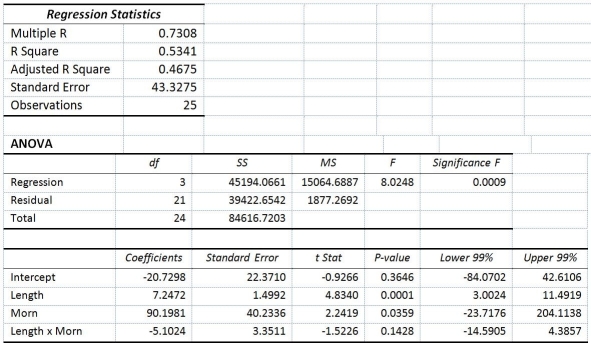TABLE 14-11
A weight-loss clinic wants to use regression analysis to build a model for weight loss of a client (measured in pounds) .Two variables thought to affect weight loss are client's length of time on the weight-loss program and time of session.These variables are described below:
Y = Weight loss (in pounds)
X1 = Length of time in weight-loss program (in months)
X2 = 1 if morning session,0 if not
Data for 25 clients on a weight-loss program at the clinic were collected and used to fit the interaction model:
Y = β0 + β1X1 + β2X2 + β3X1X2 + ε
Output from Microsoft Excel follows: 
-Referring to Table 14-11,in terms of the βs in the model,give the mean change in weight loss (Y) for every 1 month increase in time on the program (X1) when not attending the morning session.
Definitions:
Dependent Variable
A variable in an experiment or model that is expected to change in response to changes in independent variables.
Perfect Correlation
Perfect correlation occurs when two variables move in unison, either directly (perfect positive correlation) or inversely (perfect negative correlation), with a correlation coefficient of +1 or -1, respectively.
Perfect Prediction
A situation where a model or analysis predicts the outcome with 100% accuracy, with no errors.
Regression Equation
An equation that describes the line of best fit through a dataset, used to predict the outcome variable.
Q1: True or False: If we use the
Q10: Referring to Table 14-5,at the 0.01 level
Q15: True or False: The Paasche price index
Q20: Referring to Table 15-4,the "best" model chosen
Q40: Referring to Table 16-15,what are the simple
Q61: The manager of a company believed that
Q82: Referring to Table 14-4,at the 0.01 level
Q101: True or False: Referring to Table 13-12,there
Q181: Referring to Table 13-3,the coefficient of correlation
Q230: Referring to Table 14-15,what is the value